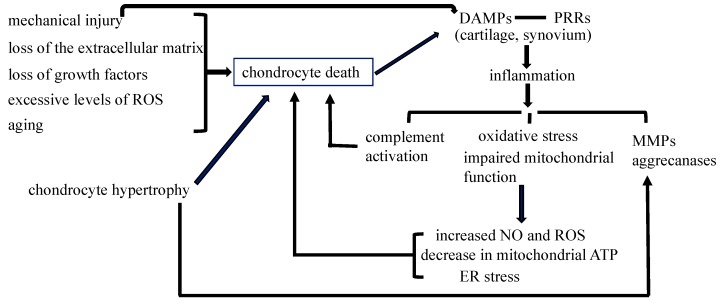Figure 1.
Chondrocyte death in osteoarthritis. Mechanical injury, the loss of the extracellular matrix, loss of growth factors, and excessive levels of reactive oxygen species (ROS) induce chondrocyte death in articular cartilage. Chondrocyte hypertrophy in articular cartilage induces the destruction of the cartilage matrix through the induction of matrix metalloproteinases (MMPs) and aggrecanases, and leads to chondrocyte apoptosis. The number of dead chondrocytes also increases in articular cartilage during aging. DAMPs (danger-associated molecular patterns) released by mechanical injury and chondrocyte secondary necrosis initiate non-infectious inflammatory responses through PRRs (pattern recognition receptors) expressed in osteoarthritis (OA) cartilage and the synovium, causing complement activation, oxidative stress, impaired mitochondrial function, and the induction of MMPs and aggrecanases. Complement activation, an increase in nitric oxide (NO) and ROS, a decrease in mitochondrial ATP, and endoplasmic reticulum (ER) stress further enhance chondrocyte death, resulting in the progression of osteoarthritis. The contribution of chondrocyte death to inflammatory processes needs to be evaluated. The inflammatory processes induced by mechanical injury contribute to the development of posttraumatic OA; however, their significance in non-posttraumatic OA remains unclear.

